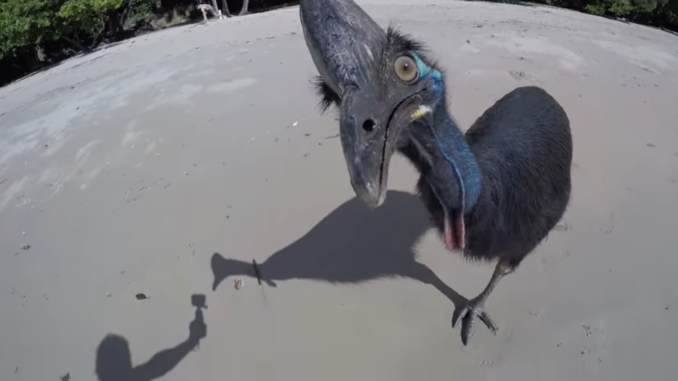
The cassowary is a direct descendant of dinosaurs and is, unfortunately, endangered. There are actually three species of cassowaries: the dwarf cassowary, the northern cassowary, and the southern cassowary. The southern cassowary is the largest of the three species. All are flightless.
In size and weight, they are comparable to the ostrich and the emu but not quite as big. Adult female southern cassowaries are larger than the males, and may be between 1.5 and 2 meters (5 to 6.5 feet) tall and weigh as much as 79 kilograms (170 pounds).
The female doesn’t stick around after she lays a clutch of eggs: it’s the male’s job to incubate the eggs and raise the chicks. (How very egalitarian of him). This leaves the female free to run around and meet other males.
In the wild, these birds live in the tropical rainforests of parts of southeast Asia and northeast Australia, although zoos and private individuals around the world keep them in captivity. Primarily their diet consists of fruit but they are true omnivores, known to eat shoots, grass seeds, fungi, invertebrates, and even small vertebrates. At least 100 tree and plant species depend on the cassowaries to eat their fruit and spread their seeds far and wide through their droppings. Without the cassowary, the rainforests they live in can’t survive. It is a critical species for the habitat.
The casque (horn or helmet) on the adult head is made of keratin. It’s beak, claws, and feathers, are also made of keratin, a protein. The purpose of the casque isn’t known, but it may amplify the sounds they make, or protect the head as the bird runs through the jungle head first at up to 30 miles per hour, or it may assist in cooling and regulating body temperature, or possibly it serves as a secondary sex characteristic to attract mates. It may be a combination of some or all of these things, no one knows for sure.
Cassowaries are vulnerable to attack by feral pigs, dogs, and dingos. Understandably, the don’t like domestic dogs or cats either as a result and have been known to attack domestic animals without provocation. Humans represent a threat as well: many cassowaries are hit by cars, their habitat is destroyed by development, and people feed the birds to everyone’s detriment.
“Giant Cassowaries are Modern-day Dinosaurs | Seven Worlds, One Planet | BBC Earth” (4:27):
They are known as “the most dangerous bird in the world” for good reason: They’re capable of causing serious injury or death. They have a powerful kick and sharp claws. The inner toe on each foot is shaped like a dagger, and is used as such in attacks.
Last year a 75-year-old Florida man was killed by the cassowary he owned (and he’s not the first). Investigators said he tripped and fell, after which the bird attacked him. Wild animals are unpredictable, particularly when they’re bonafide dinosaurs. A study published in 1999 of 221 documented attacks by cassowaries reported that the birds can be territorial, but a more likely cause of an attack was in defense of themselves and their eggs or chicks. However, by far the greatest number of reported attacks occured when cassowaries came looking for food handouts from humans and became aggressive when food was not forthcoming. Clearly, feeding wild animals encourages undesirable behavior which puts people in considerable danger. The girl who took this video was not entirely comfortable with the attention the bird was giving her. “Wild Cassowary Chases Girl on the Beach” (1:43):
Question of the night: If you were a bird,
what kind of bird would you be?
